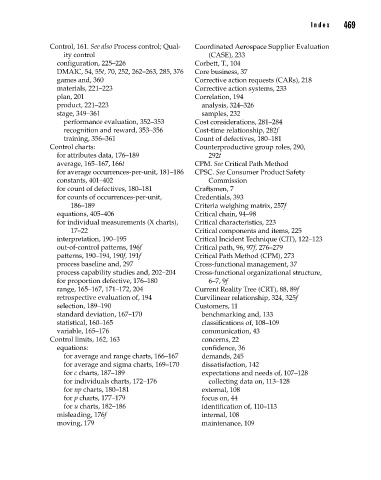Page 482 - The Handbook for Quality Management a Complete Guide to Operational Excellence
P. 482
468 I n d e x I n d e x 469
Control, 161. See also Process control; Qual- Coordinated Aerospace Supplier Evaluation
ity control (CASE), 233
configuration, 225–226 Corbett, T., 104
DMAIC, 54, 55t, 70, 252, 262–263, 285, 376 Core business, 37
games and, 360 Corrective action requests (CARs), 218
materials, 221–223 Corrective action systems, 233
plan, 201 Correlation, 194
product, 221–223 analysis, 324–326
stage, 349–361 samples, 232
performance evaluation, 352–353 Cost considerations, 281–284
recognition and reward, 353–356 Cost-time relationship, 282f
training, 356–361 Count of defectives, 180–181
Control charts: Counterproductive group roles, 290,
for attributes data, 176–189 292t
average, 165–167, 166t CPM. See Critical Path Method
for average occurrences-per-unit, 181–186 CPSC. See Consumer Product Safety
constants, 401–402 Commission
for count of defectives, 180–181 Craftsmen, 7
for counts of occurrences-per-unit, Credentials, 393
186–189 Criteria weighing matrix, 257f
equations, 405–406 Critical chain, 94–98
for individual measurements (X charts), Critical characteristics, 223
17–22 Critical components and items, 225
interpretation, 190–195 Critical Incident Technique (CIT), 122–123
out-of-control patterns, 196f Critical path, 96, 97f, 276–279
patterns, 190–194, 190f, 191f Critical Path Method (CPM), 273
process baseline and, 297 Cross-functional management, 37
process capability studies and, 202–204 Cross-functional organizational structure,
for proportion defective, 176–180 6–7, 9f
range, 165–167, 171–172, 204 Current Reality Tree (CRT), 88, 89f
retrospective evaluation of, 194 Curvilinear relationship, 324, 325f
selection, 189–190 Customers, 11
standard deviation, 167–170 benchmarking and, 133
statistical, 160–165 classifications of, 108–109
variable, 165–176 communication, 43
Control limits, 162, 163 concerns, 22
equations: confidence, 36
for average and range charts, 166–167 demands, 245
for average and sigma charts, 169–170 dissatisfaction, 142
for c charts, 187–189 expectations and needs of, 107–128
for individuals charts, 172–176 collecting data on, 113–128
for np charts, 180–181 external, 108
for p charts, 177–179 focus on, 44
for u charts, 182–186 identification of, 110–113
misleading, 176f internal, 108
moving, 179 maintenance, 109
23-Pyzdek_Index_p465-486.indd 469 11/16/12 5:15 PM

